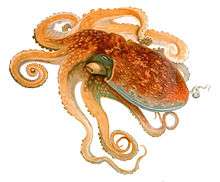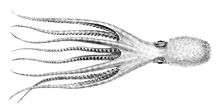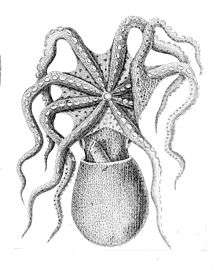Curled octopus
| Eledone cirrhosa | |
|---|---|
 | |
| Scientific classification | |
| Kingdom: | Animalia |
| Phylum: | Mollusca |
| Class: | Cephalopoda |
| Order: | Octopoda |
| Family: | Octopodidae |
| Genus: | Eledone |
| Species: | E. cirrhosa |
| Binomial name | |
| Eledone cirrhosa (Lamarck, 1798) [1] | |
The curled octopus (Eledone cirrhosa) is a species of cephalopod found in the northeast Atlantic, ranging from Norway to the Mediterranean, including the British Isles. It is alternatively known as the lesser octopus or horned octopus.
Description

It has a broad, ovoid-shaped mantle and can reach a total length (including arms) of up to 50 cm (20 in). The head is narrower than the rest of the body with a filament over each eye. The octopus's colour is yellowish or reddish-orange to reddish-brown dorsally with diffuse rust-brown patches, and white on the underside. The skin is covered with very fine, closely set granulations, interspersed with larger warts. The relatively short arms have a single series of suckers on them and at rest are held with the tips lightly curled, hence the species's common name.[2]

Habitat and distribution
The curled octopus is mainly found at depths between 0 and 150 m (0 and 492 ft) and may occur down to 800 m (2,600 ft). It lives in the northeast Atlantic Ocean, including the English Channel, the North Sea, and the Mediterranean Sea. In recent years the North Sea populations have increased, probably due to overfishing of large predatory fish such as Atlantic cod. This has had a knock on effect on crab and lobster fisheries as the curled octopus readily enters pots to take the bait or the catch.
Diet
The curled octopus feeds on crabs and other large crustaceans. It is cited as a significant predator of such commercially important species as Homarus gammarus (European lobster), Nephrops norvegicus (Norway lobster), and Cancer pagurus (edible crab) from traps.[3]
Biology
The growth rate of the curled octopus is quite rapid and its life span is generally short at 1–5 years, although there may be some variation between warmer and colder areas. The curled octopus matures at around 1 year (on reaching a total length of 12–40 cm or 4.7–15.7 in for females, slightly smaller for males) and with 1,000–5,000 eggs laid on average. It breeds at a lower rate than the partially sympatric Octopus vulgaris (common octopus). Populations are apparently at their lowest density in the autumn, probably due to post-spawning die off as reproduction involves females laying eggs, guarding them and dying once the eggs hatch. Curled octopuses are solitary animals, generally inhabiting depths of less than 100 m (330 ft), and more common in shallow water, but they have been found down to 800 m (2,600 ft).
Fisheries
The curled octopus is taken as bycatch in trawl fisheries for other species. It is also captured in earthenware pots in the Mediterranean, although the fishery for curled octopuses is less important than that of the common octopus. International Council for the Exploration of the Sea (ICES) catch data for both the curled octopus and common octopus, from all ICES regions (NE Atlantic) in 2006, indicated around 8,999 tonnes, but more recent estimates indicate a substantial increase to around 19,000 tonnes in 2008 (ICES WGCEPH, 2010). Nearly all landings of both species within these regions are taken by Portugal and Spain, with Spain taking the vast majority, although most of these will be of the common octopus.[4] Neither species is subject to either stock assessment or quota controls in Europe and in the case of the curled octopus there is no minimum size for landing.[5]
References
| Wikimedia Commons has media related to Eledone cirrhosa. |
- ↑ "Eledone cirrhosa (Lamarck, 1798)". Integrated Taxonomic Information System.
- ↑ Wilson, Emily (2008) "Eledone cirrhosa. Curled octopus". Marine Life Information Network: Biology and Sensitivity Key Information Sub-programme. Plymouth: Marine Biological Association of the United Kingdom. Retrieved 24/01/2012
- ↑ Boyle, P.R. (1986). "A Descriptive Ecology of Eledone cirrhosa (Mollusca: Cephalopoda) in Scottish Waters". Journal of the Marine Biological Association of the United Kingdom. 66: 855–865. doi:10.1017/S0025315400048487.
- ↑ Curled octopus at Fish online
- ↑ http://cmsdata.iucn.org/downloads/iucn_hotel_guide_final.pdf